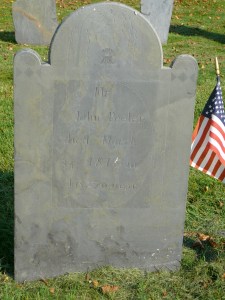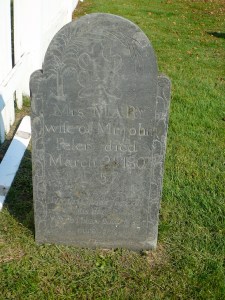Stones and bones, where can they be? — The mystery of Vernon’s vanished cemetery, Part I
By Barbara Emery Moseley
Click here for the full series on the vanished Polly Lee Cemetery and the Peeler and Lee families.
For many years the income from the Polly A. Lee Cemetery Fund has appeared in the Vernon Town Report. Possibly a few people have a faint memory of the existence of the cemetery itself, in the area of today’s Breezy Acres, off Newton Road. No traces of it remain today. Its secrets unfold with the story of Polly’s father, John Jacob Peeler.
During the American Revolution, he was among the 29,000 Hessian mercenaries bought by the British Army. They had been purchased like cattle, at so much per head. The money maintained the Grand Duchy of Hesse, an area of Germany near today’s Frankfurt.
As an oppressed person himself, Peeler hated the British. Instead, he felt a great admiration for the Americans fighting so bravely against tyranny. He wanted to fight alongside them, and at the first opportunity, he deserted. Before reaching American lines, he was captured, and given 39 lashes, a punishment common in the British Army. The lashes were administered using the cat-o’nine tails, a whip with nine lashes of knotted cords.
Almost immediately, he deserted again, was recaptured and received 99 lashes, the usual penalty for a second offense. He was warned that a third offense would result in his being flogged to death, for no one was expected to survive the “thousand lashes save one” inflicted in such cases.
However, his stubborn determination to join the Americans did not waver. Learning the Army of King George III was preparing for a major battle, he deserted once more. He was discovered by John Hare, a British soldier whom he knew well. Hare had the opportunity to let Peeler escape and was offered five pounds by him. Hare scoffed, saying he could get five pounds for Peeler’s return, adding that he wasn’t confident Peeler would survive another whipping and be able to pay him back. At that point, Peeler made a promise to himself that he would survive, and one day would find Hare and kill him.
Peeler was taken back to camp, tried by a court-martial and, with two others, whipped “one thousand lashes save one.”
One of the three died before the 999 strokes were complete, but the strokes were continued just the same, even in his dying moments. All three were placed into a hut. It had only a bed of straw for comfort, and a small bowl of gruel was the daily food ration. Peeler urged his companion to exercise, but he wouldn’t, dying the third day. His death was kept secret by Peeler, who at the man’s portion of gruel.
Peeler, a man of large physique, exercised and crawled about when not being observed, and recovered. (Later, his daughter Polly said his back was “one huge scar.”)
When Peeler felt back to full strength, he disclaimed total recovery, but admitted he was able to do light work. The surgeon of the regiment gave him a bog hoe and told him to go into a nearby swamp, to dig some roots for the medicine chest. When well out of sight, Peeler dropped the bog hoe, and hid until dark. In preparation for their next day’s assault on Breed’s Hill (Bunker Hill), the British Army was too busy to notice his escape. He was able to reach the American lines.
After the war’s end, Peeler settled in Walpole, N. H. and there he married Mary Polly Flagg. In 1787, his daughter Polly was born there. After a brief move to Greenfield, Mass., the family came to Vernon. Shortly after his arrival, through a comrade he had news of John Hare. The man had stayed in this country and was living in New York State. Like Vermont, large parts of it were still wilderness.
Peeler prepared himself as though for a war campaign, molding bullets, putting his gun in order, filling his powder horn, and packing his knapsack. A neighbor woman knitted him a cap, mittens and some socks. He left quietly and was gone for three months.
On his return, he set his gun in the corner and remarked, “I have put John Hare where the Devil won’t find him,” and asked for food.
He settled down quietly on his farm, and no neighbors asked him for particulars about his journey. He died in 1815, at the age of 70; he had fathered 14 children. He was buried in Tyler Cemetery, where he wife had been buried in 1807.
If you believe in ghosts, the apparitions of both father and daughter may drift over to Huckle Hill Road. You may think it’s just low-lying fog, but best you slow down on that first curve…
More in the next installment about Polly and the vanished cemetery!


